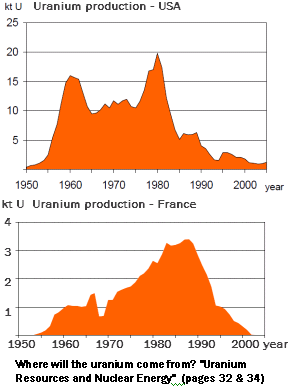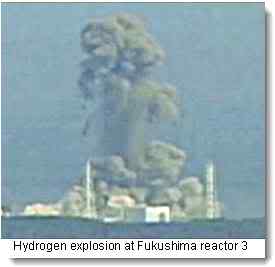The Truth About Nuclear Power - Too Dangerous to Tell
If you think Fukushima is bad, find out about what the future of nuclear power offers the world.
A poster at The Agonist, Joaquin, published an elegant and important analysis this weekend. His tightly packed, brief post made three key points. We're headed for an ugly future with nuclear power based on shortages and future fuel cycles more volatile than those imploding and exploding in Japan. Governments, the nuclear industry, and the media are avoiding this issue entirely. As a result, the rulers and technocrats who got us to the latest meltdown cannot be trusted to make any more decisions about energy needs. (Image)
"The truth is, there is a big fat lie that the nuclear power industry and the media are foisting on the public and that has not changed." Joaquin
"What is it", the big fat lie, Joaquin asks.
"This lie has to do with the nature of nuclear power in the future. Everyone is asking, can we make nuclear technology, the current, nuclear technology safe? In truth, the current risks with the nuclear fuel cycle i.e., the risks of contaminating the environment, are not the risks of the future because the current nuclear fuel cycle is not the fuel cycle that will be used in the future. There's just not that much uranium left to fuel an extensive expansion of nuclear power generation." Joaquin (See Note 1)
By 2015, the supplies of uranium will be in sufficient decline to limit nuclear energy. Or will they?
"This assessment results in the conclusion that in the short term, until about 2015, the long lead times of new and the decommissioning of aging reactors perform the barrier for fast extension, and after about 2020 severe uranium supply shortages become likely which, again will limit the extension of nuclear energy." Uranium Resources and Nuclear Energy, 2006

The United States and France, heavy nuclear users, will be out of domestic supply and world supply is questionable. It takes semantic tricks by industry representatives to claim otherwise. (See Note 2)
Joaquin offers up the future of nuclear power, the future carefully avoided by governments, the nuclear industry, and the media. Instead of the current generation of plants, the nuclear industry will give us "improved reactors" and fuel cycles that require less uranium. Supplementing that will be imports from the same type of unreliable suppliers that we have for petroleum (e.g., Kazakhstan, the Soviet Union).
"So, where's all the nuclear fuel going to come from? The answer has to be that the nuclear industry and U.S. government intend to use more exotic fuel cycles in the future power plants including, MOX (currently leaking our of Fukushima1, unit 3), reprocessed Uranium, Thorium, and breeder reactors of various types (See Note)
"The industry and their government and media proxies don't want to talk about this fact too much because the waste from these future fuel cycles is far more dangerous than most of the stuff slowly making a large part of Japan uninhabitable for the next few dozen millennium. In other words, the discussion in the media about future nuclear safety is completely dishonest." Joaquin
The "See Note" link provides more details on the dangers and questionable availability of these future nuclear fuel cycles. We're witnessing a preview of the future with the MOX cycle. Fukushima I, unit 3, began using MOX in September 2010. Here's a nuclear engineer formerly with Tokyo Power on unit 3:
"Goto said that the MOX also has a lower melting point than the other reactor fuels. The Fukushima facility began using MOX fuel in September 2010, becoming the third plant in Japan to do so, according to MOX supplier AREVA." D.C. Bureau March 15
Joaquin's point on the dangers of new fuel cycles is well taken. One of the fuels of the future, MOX, has a low melting point than the other reactors at Fukushima. Maybe that's why it had an, as of yet, unexplained hydrogen explosion in MOX fueled reactor 3. The others outlined in the note are no more assuring as a future source. Nevertheless, the nuclear industry persists in acting like it has a viable supply to meet it's demands and promises.
"We are supposed to believe that this hydrogen explosion (first image above) at unit 3, March 14, is no biggie; of course it isn't; it's just a direct hit. WTF, there is a huge amount of concrete flying hundreds of meters in the air not a tin roof; the nature of the damage done by this explosion has proven to be the subject of one lie after another." Joaquin
The dangers of unit 3 are clear:
"The No. 3 reactor is a particular concern because it is the only one of six at the plant to use a potentially volatile mix of uranium and plutonium." ABC News, March 26
Joaquin examined a perfect example of media denial in reporting toxic dangers from the disaster.
"The media is confusing everyone about radiation because they refuse or are unable to discern the difference between contamination and direct radiation. That's because the media are run by people who are either trying to obfuscate what is going on or are just plain idiots; your choice. Look at this picture: compiled from Sources: Tepco (Tokyo Power); International Atomic Energy Agency; Federal Aviation Administration; Nuclear Regulatory Commission.
"Never-mind that most of the data is missing in the above picture, which seems to say the plant is safe to walk around in anytime as long as you don't mind the possibility of a CT-SCAN now and then. Today, several plant employees found out the hard way what a dangerous lie this is." Joaquin
The picture and timeline from the New York Times, March 25 referenced by Joaquin shows how little the media demands from officials sources. The top official in the Japanese cabinet, Yukio Adono, flat out admitted that there was no monitoring for toxic particles, the real danger for contamination. From the video: "Unfortunately we are not able to measure the radioactive materials [in the atmosphere]…That is something we're trying to work out."
"When it comes to radioactive materials in general in the atmosphere, we are now trying to measure it and then we will see how much of the ratio active materials are actually emitted from the nuclear power plant. We are trying to come up with an estimate for that." Yukio Adono, CNN Video, March 23, Starts at 1:06
Where is the coverage? Where are the questions? Measuring "radioactive materials" in the atmosphere is precisely the type of measurement that goes to health and safety concerns.
The inevitable conclusion about the current stewards of energy policy and information is clear:
"Clearly, given the lies coming out of Japan and the media's willing participation in them, nuclear energy is too dangerous for the truth and that these institutions are too corrupt to act as responsible stewards of such a dangerous existing technology." Joaquin
If you think Fukushima is bad, just wait for the bright and shining future offered by those who control the levers of power. They're just warming up.
Extended quotations provided with the permission of the author. Original article first published in The Agonist.
END
Also see: Joaquin's original post Is Nuclear Power too Dangerous toTell the Truth About? and
New Scientist - Fukushima radioactive fallout nears Chernobyl levels by Michael Collins
You may reproduce this article entirely or in part with attribution of authorship to Joaquin and a link to the article.




 del.icio.us
del.icio.us Digg
Digg












Post your comment